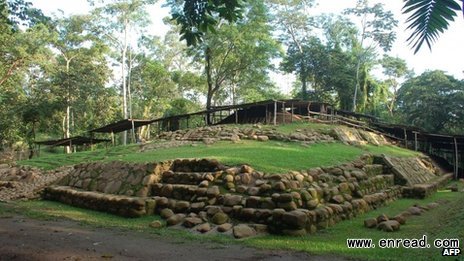| ||||||||||||||||||||||||||||||||
|
One of the oldest Mayan tombs ever found has been uncovered in western Guatemala, say archaeologists.
考古学家称,一座最古老的玛雅坟墓在危地马拉西部被发现。
 The scientists named the grave's occupant K'utz Chman, which in the Mayan language means Grandfather Vulture, due to a vulture-headed figure found at the site Located at a temple site in Retalhuleu province, the grave is thought to be that of an ancient ruler or religious leader who lived some 2,000 years ago.
Carbon-dating indicated the tomb had been built between 700 and 400 BC, said government archaeologist Miguel Orrego.
A rich array of jade1 jewels, including a necklace depicting2 a vulture-headed human figure, were found.
The scientists found no bones at the tomb in the Tak'alik Ab'aj site - some 180km south of Guatemala City - probably because they had disintegrated(分解,瓦解).
But the vulture-headed figure appears to identify the tomb's occupant as an ajaw - or ruler - because the symbol represented power and economic status and was given to respected elder men.
Big chief
The scientists named the grave's occupant K'utz Chman, which in the Mayan language, Mam, means Grandfather Vulture.
"He was a big chief", said Mr Orrego. "He bridged the gap between the Olmec and Mayan cultures in central America."
The leader may have been the first to introduce elements which later became characteristic of the Mayan culture, such as the building of pyramids and the carving3 of sculptures depicting the royal families, Reuters news agency cited historians as saying.
The Olmec empire began to fade at around 400 BC, while the Maya civilisation4 was starting to grow and develop, said Christa Schieber, another archaeologist working at the site.
The Mayas went on to rule much of Central America from 250 to 800 AD; their empire extended from modern-day Honduras to central Mexico.
点击  收听单词发音 收听单词发音
|
||||||||||||||||||||||||||||||||
上一篇:超人从《星球日报》辞职 下一篇:男性丧偶后死亡率上升 |
||||||||||||||||||||||||||||||||
- 发表评论
-
- 最新评论 进入详细评论页>>



